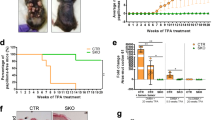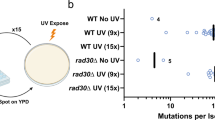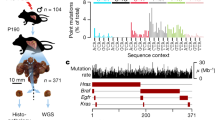Abstract
When Escherichia coli is chronically exposed to very low, nontoxic doses of a monofunctional alkylating agent (notably N-methyl-N′-nitro-nitrosoguanidine, MNNG), the adaptive DNA repair pathway is induced which enables the bacteria to resist the killing and mutagenic effects of further alkylation damage1–3. Mutation resistance in adapted bacteria is achieved, at least partly, by a greatly increased capacity of the cells to eliminate the minor DNA alkylation product O6-methyl-guanine4–6, which has been strongly implicated as premu-tagenic7,8 and precarcinogenic9. We now show that the chronic treatment of a Chinese hamster ovary (CHO) and a SV40-transformed human skin fibroblast (GM637) cell line with non-toxic levels of MNNG renders the cells resistant to the induction of sister chromatid exchange (SCE) by further alkylation damage. CHO cells also become resistant to killing (GM637 cells have not yet been tested). Having ruled out explanations such as changes in cell cycle distribution, mutagen permeability and mutagen detoxification, we conclude that resistance is probably achieved by the cells becoming more efficient at repairing alleviation damage, analogous to the adaptive response of E. coli1.
This is a preview of subscription content, access via your institution
Access options
Subscribe to this journal
Receive 51 print issues and online access
$199.00 per year
only $3.90 per issue
Buy this article
- Purchase on Springer Link
- Instant access to full article PDF
Prices may be subject to local taxes which are calculated during checkout
Similar content being viewed by others
References
Samson, L. & Cairns, J. Nature 267, 281–283 (1977).
Jeggo, P., Defais, M., Samson, L. & Schendel, P. Molec. gen. Genet. 157, 1–9 (1977).
Jeggo, P., Defais, M., Samson, L. & Schendel, P. Molec. gen. Genet. 162, 299–305 (1978).
Schendel, P. F. & Robins, P. E. Proc. natn. Acad. Sci. U.S.A. 75, 6017–6020 (1978).
Robins, P. & Cairns, J. Nature 280, 74–76 (1979).
Karran, P., Lindahl, T. & Griffin, B. Nature 280, 76–77 (1979).
Loveless, A. Nature 223, 206–207 (1969).
Gerchman, L. L., Ludlum, D. B. Biochim. biophys. Acta 308, 310–316 (1973).
Goth, R. & Rajewsky, M. F. Proc. natn. Acad. Sci. U.S.A. 71, 639–643 (1974).
Montesano, R., Bresil, H. & Margison, G. P. Cancer Res. 39, 1798–1802 (1979).
Montesano, R., Bresil, H., Planche-Martel, G., Margison, G.P. & Pegg, A. E. Cancer Res. 40, 452–458 (1980).
IARC Monographs on the Evaluation of the Carcinogenic Risk of Chemicals to Humans Vol. 1, 95–106 (International Agency for Research on Cancer, Lyon, 1972).
Schendel, P. F., Defais, M., Jeggo, P., Samson, L. & Cairns, J. J. Bact. 135, 466–475 (1978).
Carrano, A. V., Thompson, L. H., Lindl, P.A. & Minkler, J. L. Nature 271, 551–553 (1978).
Wolff, S., Rodin, B. & Cleaver, J. E. Nature 265, 347–349 (1977).
Jensen, E. M., LaPolla, R. J., Kirby, P. E. & Haworth, S. R. J. natn. Cancer Inst. 59, 941–944 (1977).
Lawley, P. D. & Thatcher, C. J. Biochem. J. 116, 693–707 (1970).
Barranco, S. C. & Humphrey, R. M. Mutat. Res. 11, 421–429 (1971).
MacRae, W. K., MacKinnon, E. A. & Stich, H. F. Chromosoma 72, 15–22 (1979).
Wheeler, G. P. & Bowdon, B. J. Biochem. Pharmac. 21, 265–267 (1972).
DasGupta, U. B. & Summers, W. C. Proc. natn. Acad. Sci. U.S.A. 75, 2378–2381 (1978).
Sarasin, A. & Benoit, A. Mutat. Res. 70, 71–81 (1980).
Wolff, S. & Rodin, B. Science 200, 543–545 (1978).
Author information
Authors and Affiliations
Rights and permissions
About this article
Cite this article
Samson, L., Schwartz, J. Evidence for an adaptive DNA repair pathway in CHO and human skin fibroblast cell lines. Nature 287, 861–863 (1980). https://doi.org/10.1038/287861a0
Received:
Accepted:
Issue Date:
DOI: https://doi.org/10.1038/287861a0
This article is cited by
-
Comparative assessment of antimicrobial, antiradical and cytotoxic activities of cannabidiol and its propyl analogue cannabidivarin
Scientific Reports (2021)
-
Adaptive responses to low doses of radiation or chemicals: their cellular and molecular mechanisms
Cellular and Molecular Life Sciences (2019)
-
Adaptive response induced by low dose ionizing radiation in human cervical carcinoma cells
Archives of Pharmacal Research (1995)
-
Induction of gene conversion in yeast cells continuously cultured at high radiation background
Radiation and Environmental Biophysics (1995)
-
After X-irradiation a transient arrest of L929 cells inG 2-phase coincides with a rapid elevation of the level of O6-alkylguanine-DNA alkyltransferase
Radiation and Environmental Biophysics (1991)
Comments
By submitting a comment you agree to abide by our Terms and Community Guidelines. If you find something abusive or that does not comply with our terms or guidelines please flag it as inappropriate.



